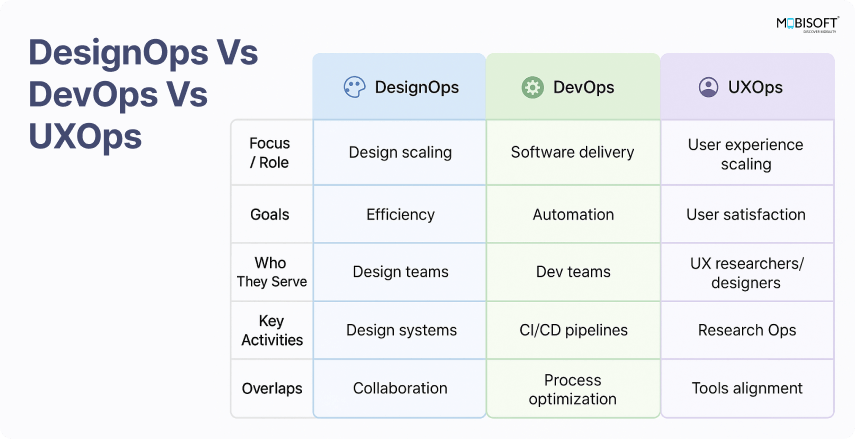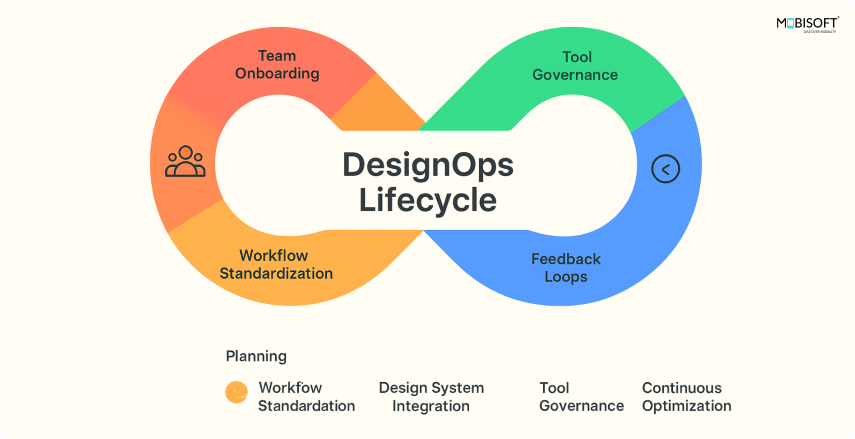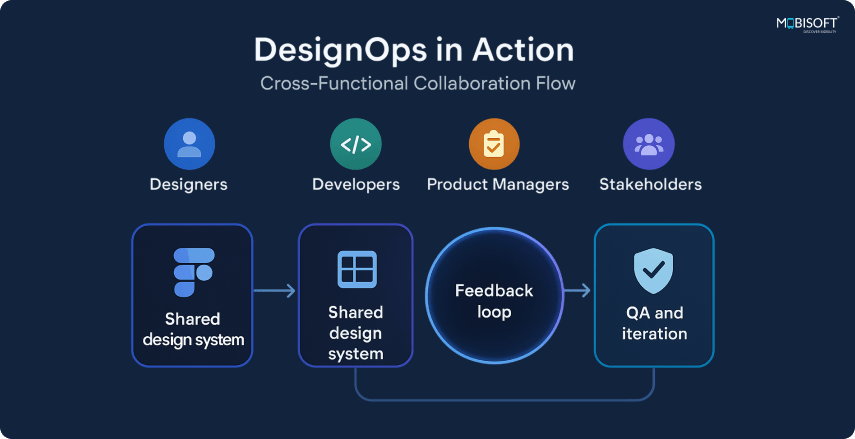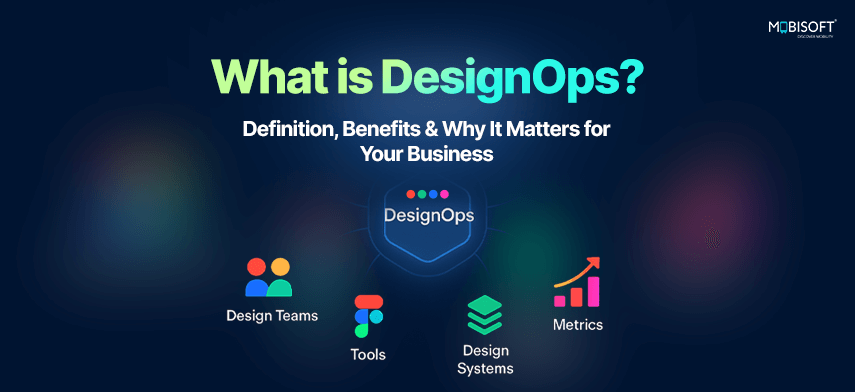As design teams grow, so does the pressure to deliver stronger user experiences. Many companies find it hard to keep up. That’s exactly where DesignOps steps in. It’s a way to bring order to design work, improve how teams collaborate, and scale practices without letting quality slip.
If you’ve ever wondered what DesignOps means or looked for a clear DesignOps definition, this section will clear it up. We’ll look into its purpose, impact, and how it works in practice.
What Is DesignOps?
DesignOps, short for Design Operations, is the setup of processes, systems, and tools that let design teams work better. The aim is simple: reduce friction, encourage teamwork, and keep results consistent even as teams get larger.
It is helpful to think of this in the same way as DevOps, but applied to design. Just as DevOps has changed the way software is delivered, DesignOps is changing how design operates in an organization. It brings designers, product managers, engineers, and business stakeholders together, and everyone is working toward the same goals for business objectives. This approach is often described as the DesignOps framework, helping companies manage design at scale.
Explore our UI/UX DesignOps services to see how organizations are structuring design processes effectively.
Why DesignOps Matters

Before we talk about efficiency, let's take a second and take a step back. Picture your design team in a disorganized kitchen. Without process, everyone is running around, ingredients disappear, and food comes late.. DesignOps is an organized kitchen that provides a space where the team can focus on making great experiences without colliding with one another.
Optimizing Design Efficiency
DesignOps matters because it prevents design teams from descending into chaos. Without systems, files go missing, projects clash, and progress stalls.
With the right DesignOps processes, everything runs smoothly. Workflows are established, tools assist with repetitive work, and optimizing design workflows with DesignOps cuts out delays. This leads to fewer duplicate tasks, issues, and more projects being completed on time and on budget.
This affects the whole company. When design runs faster and mistakes drop, products move through development quickly. And the business gets ideas into the market before competitors.
Learn more about streamlining UX workflows with DesignOps for scalable and efficient operations.
Improved Collaboration Across Teams
Design often happens in a bubble. Teams focus on their deadlines, while engineering, product, and marketing move in different directions. The result? Gaps, rework, and sometimes disappointing outcomes.
DesignOps cuts down barriers. It creates structures so people can communicate, share resources, and work toward shared objectives. Having daily meetings creates a design system that acts as a shared repository, or uses better collaboration software. In this way, DesignOps for cross-functional collaboration strengthens alignment and improves results across the organization.
Explore how DesignOps for mobile UX enhances collaboration in mobile product teams.

Scaling Design Across the Organization
Growth changes everything. A startup can get by with one designer covering all needs. But when the business expands, design requests multiply, and chaos follows if nothing scales with it.
DesignOps solves scaling challenges by making design repeatable. Standard tools, shared processes, and structured design systems help large teams work consistently. Whether it’s five people or fifty, or whether you’re supporting one product or several, the output must feel unified. That consistency matters when the company is moving fast and resources are stretched. This is why many businesses invest in DesignOps consultancy and services to establish scalable practices.
Learn how DesignOps for design systems supports scalability with reusable frameworks.
Developing a Consistent Design Language
Consistency is likely the biggest design challenge. If all the products or features are different-looking, then the brand is fractured. Users notice it, and it destroys trust.
DesignOps deals with this by putting design system operations at center stage. Reusable elements, shared patterns, and clear rules provide a single source of truth for teams. Instead of starting from scratch, designers borrow from a shared repository. This saves time, is quicker, and maintains a smooth user experience for everyone.
Read how AI in UX design is shaping smarter, more consistent design decisions.
Facilitating Design Leadership and Strategy
Lastly, DesignOps provides design leaders with room to lead. Otherwise, they are bogged down with admin work. such as tool administration, searching for files, or following up with projects rather than strategy.
Once the operations are established, leaders can focus on vision and team-building. Good processes, infrastructure, and resources enable more innovative design while maintaining alignment with business objectives. This highlights the importance of DesignOps in making design a strategic driver rather than a support function.
Discover how UX impacts business outcomes and why design leadership plays a crucial role.
Key Components of DesignOps

To understand what DesignOps is, it's a good idea to know its elements by decomposing them. They are:
Design Systems
Design systems are very crucial for DesignOps. A design system is a collection of components, patterns, and rules that can be reused, allowing design teams to be consistent and excel on various projects. It brings design materials and rules together, allowing teams to produce quality work within a short amount of time, and all products look and feel identical to the brand.
Firms like Airbnb, IBM, and Google have created design systems (e.g., Material Design or Carbon Design System) that provide the teams with tools to assist them in designing products similarly. These examples also serve as best practices for DesignOps in design teams, highlighting the importance of DesignOps in product development and its role in design scalability.
Learn more about the importance of UX research in building effective design systems.
Tools and Software
DesignOps is all about choosing the right tools to successfully design. This incorporates design-coordinating tools like Figma or Sketch, work management tools like Trello or Asana, and prototype tools like InVision. Picking the right software is a decent step in establishing a streamlined workflow.
By bringing all of these DesignOps tools and platforms into one system, design teams can communicate, collaborate, and create something useful at each stage of the design process. This reflects how DesignOps improves design teams by enabling smoother collaboration and alignment.
Processes and Workflows
DesignOps is all about creating repeatable and efficient product design processes. It is about creating standard processes for tasks such as initiating projects, design reviews, user testing, or handing over designs from design teams to development teams.
This reflects the DesignOps framework in action: eliminating waste, reducing uncertainty, and avoiding arbitrary decisions, while ensuring clear and consistent workflows. In many cases, this mirrors the impact of DesignOps in agile environments where efficiency and clarity are crucial.
Teamwork and Communication
One of the signatures of DesignOps is successful collaboration. Through the implementation of regular check-ins, channels of feedback, and cross-functional meetings, DesignOps instills a communication culture such that designers, developers, and product managers are all on the same page at all times.
This means there's less handoff misery, better user need comprehension, and better deliverables. DesignOps for cross-functional collaboration is one of its biggest benefits, helping teams align on both user and business goals.
Metrics and Analytics
DesignOps is all about tracking performance and measuring the success of design work. By measuring time-to-completion, user engagement, and design quality, you'll be able to track and tweak design rituals. Data-based analysis lets you examine opportunities for improvement, and you can act on needs as they arise. Here, DesignOps metrics and KPIs provide visibility into whether workflows are improving and whether teams are scaling effectively.
How to Implement DesignOps in Your Organization

Before you begin the steps, consider this: making DesignOps happen is less like a light switch than it is cleaning out a cluttered workshop. Make small, deliberate changes initially to serve the team and to experiment with what works prior making bigger decisions.
Start Small, Scale Gradually
If DesignOps feels new, don’t try to overhaul everything at once. Start with the obvious pain points, maybe slow handoffs, messy files, or scattered design assets. Fix those first. Once you see what works, expand gradually. Think of it like tuning a machine: small tweaks early save headaches later. This is often how DesignOps in enterprise product teams begins small steps that grow into organization-wide adoption.
Create a Design System
A design system really is your safety net. Be it building one from scratch or improving an old setup, centralizing guidelines, reusable components, and assets keeps things tidy. Your team wastes far less time hunting for files, and the output stays consistent across products, projects, and even new hires. This is one of the key components of DesignOps when scaling design operations.
Choose the Right Tools
The tools matter, but pick them wisely. They should match your workflow, help teams collaborate, and handle repetitive tasks so designers can focus on creative work. I’ve seen teams adopt shiny tools that end up unused. Make sure your choice solves real pain points, not just looks fancy. Selecting the right DesignOps services and tools is a big part of building an effective system.
Foster Cross-Functional Collaboration
DesignOps strategy thrives on teamwork. Ensure that designers, developers, product managers, and stakeholders communicate with one another frequently. Check-ins, feedback loops, and common workspaces all aid. When everyone is in the know, you can steer clear of last-minute surprises and ensure designs align with business and user objectives.
Measure and Improve
Don't set it and forget it. Monitor what your system is doing, how fast projects are completing, whether teamwork is improving, and whether design is being implemented correctly. Look where you can adjust things slightly. They add up over time to make processes more efficient and results improved.
Conclusion
DesignOps practices are about changing your mindset. It makes design better, eliminates waste, and creates better user experiences.. By centering on systems, collaboration, and sound design practices, you enable your team to do their best.For any company, embracing DesignOps in enterprise product teams also involves building a culture where collaboration, imagination, and problem-solving are the norms. If you want to enhance your design practice, this strategy provides you with a clear and practical means to empower your team to achieve maximum potential.





 June 20, 2025
June 20, 2025


